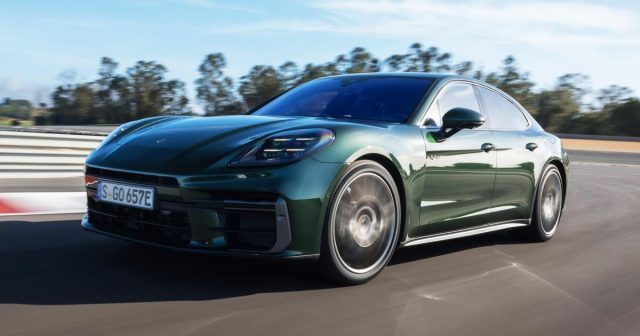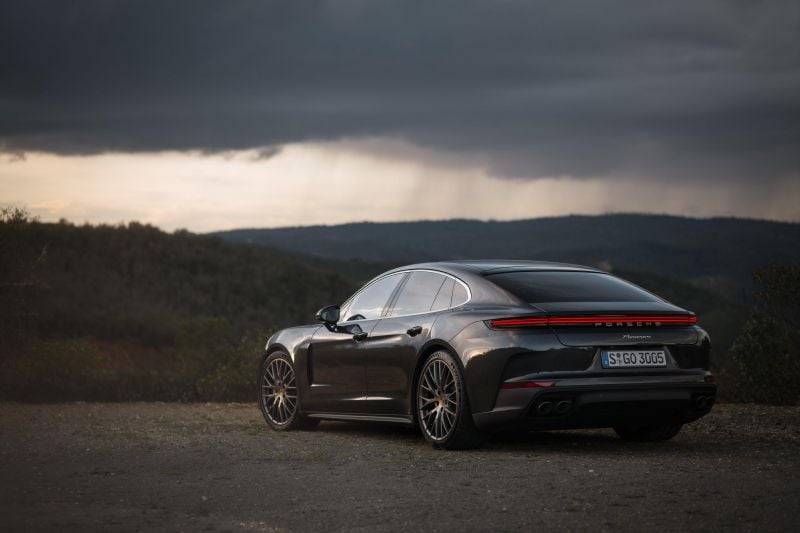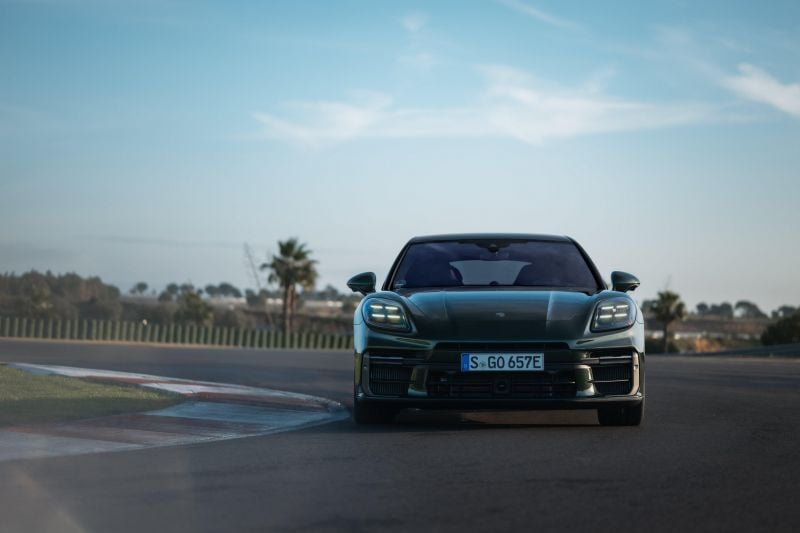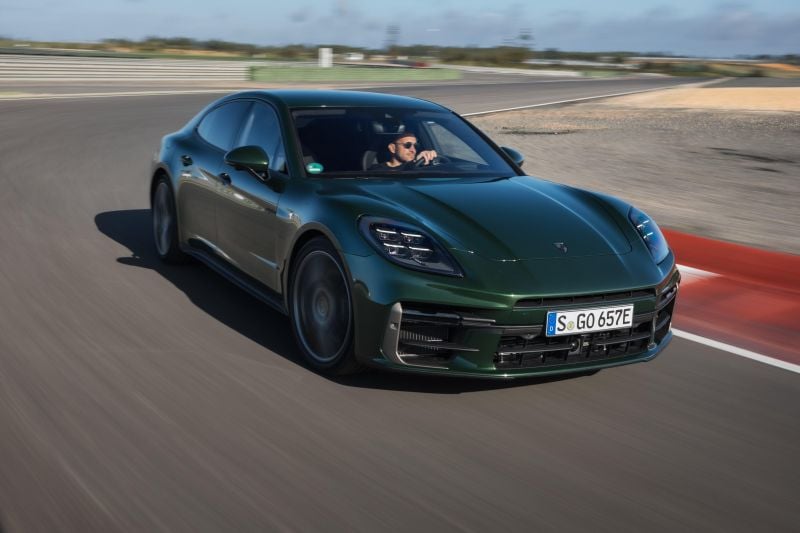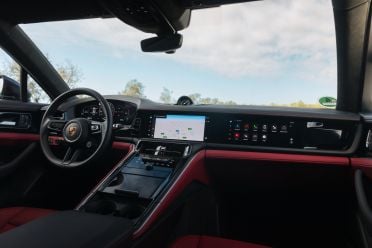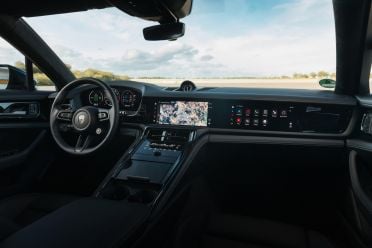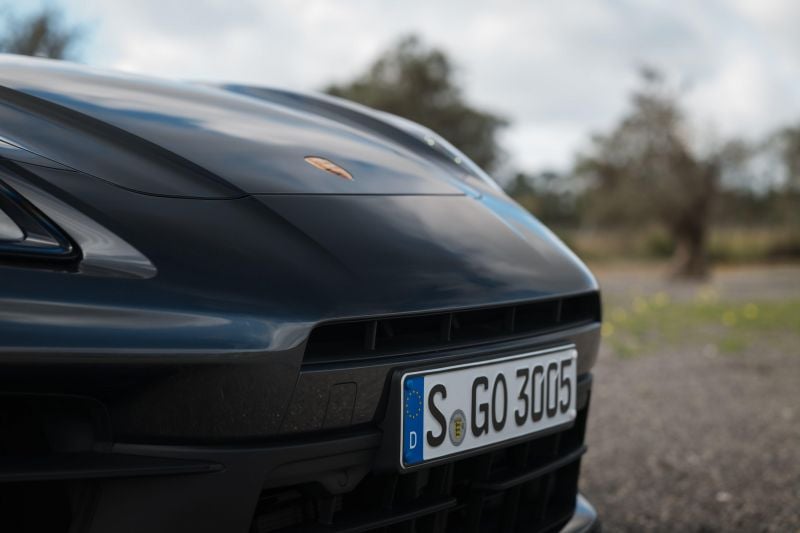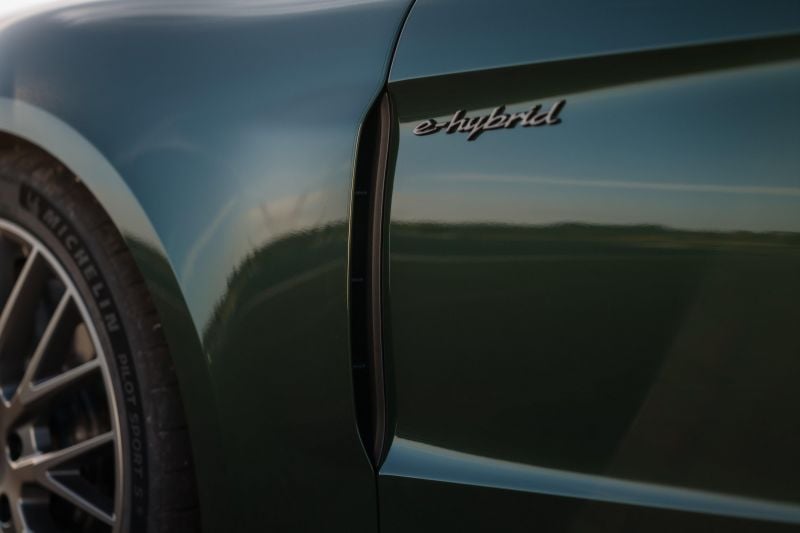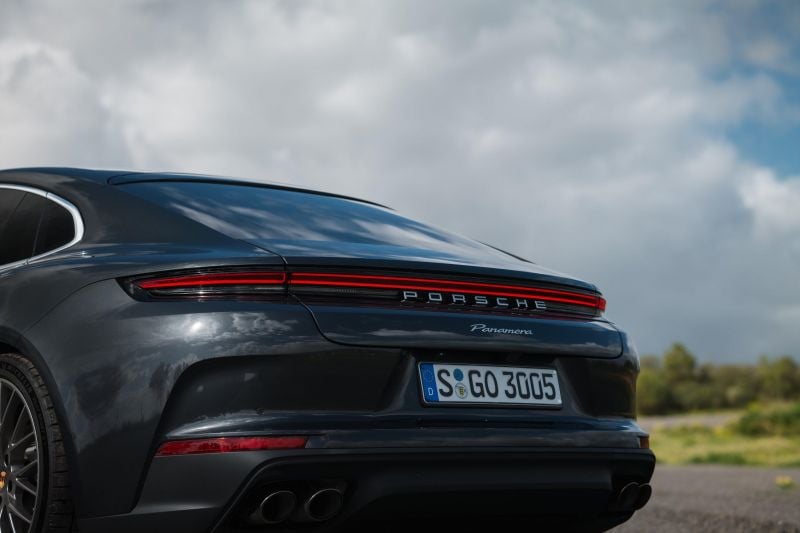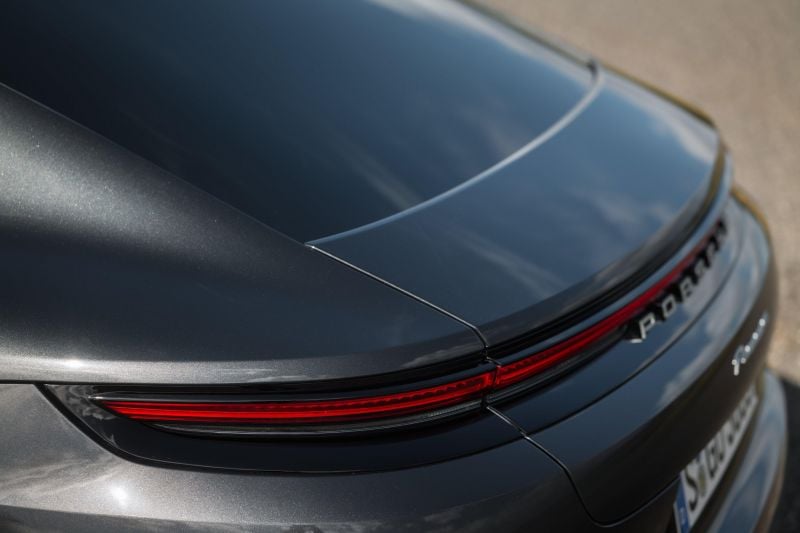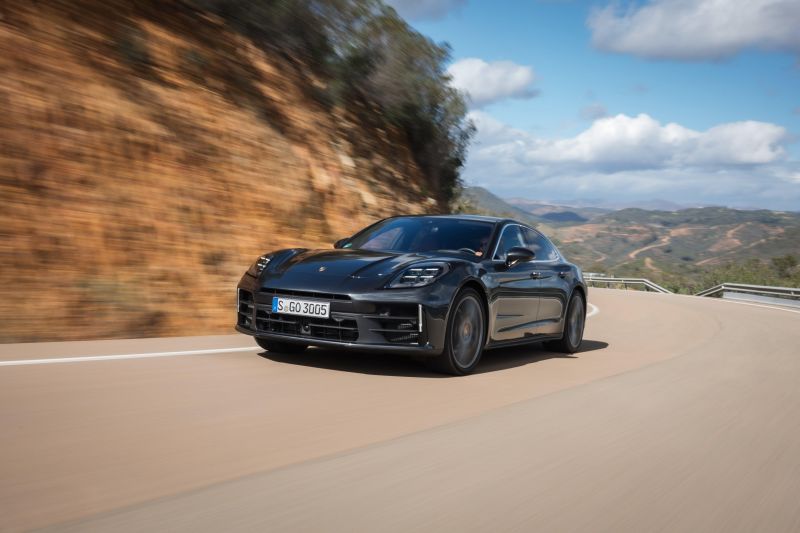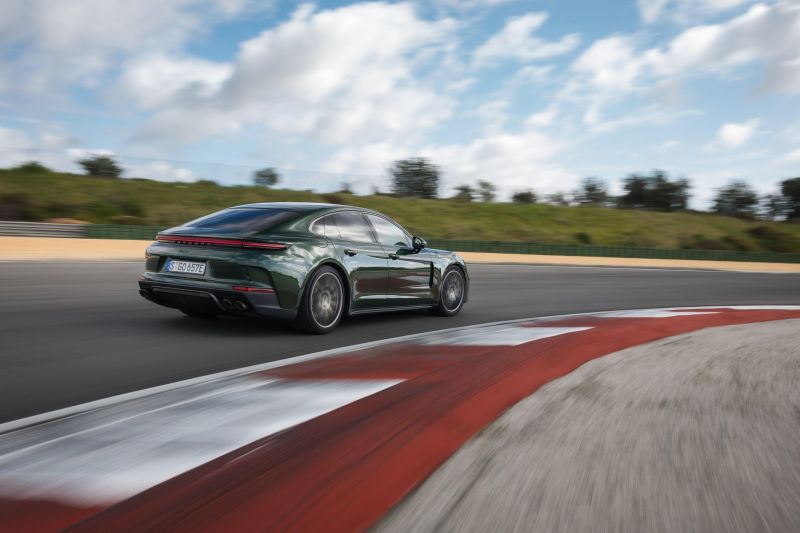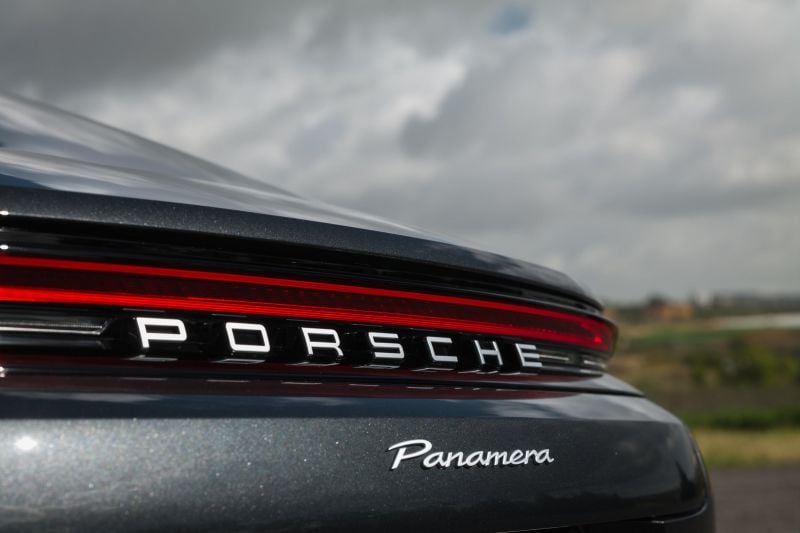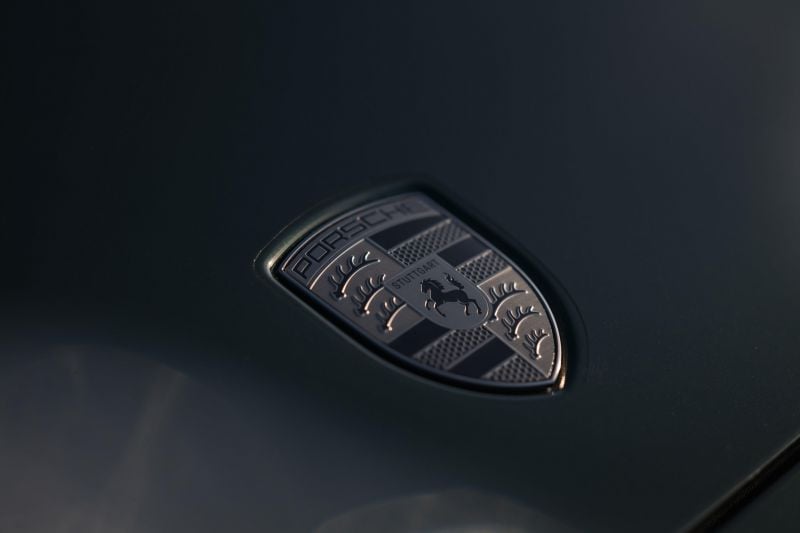At first glance, the 2024 Porsche Panamera looks a lot like a facelift of the existing car. But the changes are more than skin deep.
For one thing, this Panamera debuts Porsche’s first ever active suspension, dubbed Porsche Active Ride (PAR). The interior has also been redesigned and the car’s digital connectivity upgraded.
Oh, and there’s more performance, courtesy of upgrades to the V6 and V8 E-Hybrid plug-in hybrid (PHEV) powertrains.
Introduced in 2009, the original Panamera was – let’s be kind – an oddly hunchbacked thing, a legacy of then Porsche boss Wendelin Wiedeking’s demand that his 198cm frame be readily accommodated in the rear seat of the first four-door Porsche in history.
Wiedeking has long since gone, and the switch to VW Group’s MSB platform hardware for the second-generation car launched in 2016 gave Porsche design boss Michael Mauer the freedom to fix his vainglorious legacy.
For the 2024 Panamera every exterior panel has been redesigned, apart from the door skins. The new front bumper fascia features larger air intakes, including a vent above the front number plate, and air blades are integrated into the outermost vents to improve aerodynamic efficiency.
The bonnet is more sculpted, and the top of the front guards has been raised to give drivers a more 911-like view through the windscreen.
At the rear, above the new rear bumper and rear lights, is a new hatchback lid with glass that extends out to the inner edge of the pillars rather than being enclosed in a metal frame.
But perhaps the most significant styling change, most noticeable on cars with bright trim around the side windows, is the slightly more formal double apex kink in the C-pillar that replaces the 911-like swoosh of the outgoing car.
How does the Porsche Panamera compare?
View a detailed breakdown of the Porsche Panamera against similarly sized vehicles.

Porsche
Panamera
How much does the Porsche Panamera cost?
Porsche Australia currently has two new Panamera models available for order.
2024 Porsche Panamera pricing:
- 2024 Porsche Panamera: $227,000
- 2024 Porsche Panamera Turbo E-Hybrid: $403,200
Prices exclude on-road costs
Three more Panamera models will be announced in April. They are all six-cylinder, all-wheel drive plug-in hybrid models – the Panamera 4 E-Hybrid and long wheelbase Panamera 4 E-Hybrid Executive, and the more powerful Panamera 4S E-Hybrid.
There’s been no official word on pricing, but the 4 E-Hybrid is likely to start at under $270,000, with the 4 E-Hybrid Executive coming in at under $290,000 and the 4S E-Hybrid at under $310,000.
What is the Porsche Panamera like on the inside?
While the basic interior layout and design echoes that of the outgoing model, the new Panamera now features the same multi-screen dash layout as the electric-powered Taycan.
The 12.6-inch digital instrument panel is split into three independently configurable sections. At the centre of the dash is a 12.3-inch touch screen, and a 10.9-inch screen for front seat passenger is available as a $3140 option.
This latter screen can be used to stream video content while the car is moving, as it digitally shields the display from the driver’s view to avoid distraction.
One thing you won’t find in the new Panamera is a shifter in the centre console. The eight-speed dual clutch transmission is now controlled by a small toggle-like gear selector similar to that used in the 911 that is located on the dash, next to the steering wheel.
Removing the central shifter has freed up space on the centre console for touch-sensitive control surfaces with tactile feedback.
However, the driver and front passenger control the temperature, the ventilation level and switch the air conditioning on and off via five physical climate switches. Directly below these is a mechanical rotary push button that controls the audio system volume.
The new, louvre-less air vents are one of those high-tech solutions to a problem that didn’t need solving. Rather than simple, intuitive, flick-and-slide physical vents, the airflow is controlled via pre-programmed automatic ventilation modes.
If you don’t like any of those, you must go into a menu on the central touchscreen and move the airflow in the direction you wish.
Redesigned door trims feature elements that can be configured in a mix and match of colours and materials. Ambient lighting is bounced off surfaces in the doors and under the dash to produce gentle washes of colour around the cabin.
To differentiate the Turbo from lower-powered Panameras, its interior comes standard with matt carbon trim and accents in a metal-like finish called Turbonite. Also used on the wheels, badging, exhaust outlets and other exterior trim elements, Turbonite is a dark sliver with a subtle bronze wash that looks very classy.
What’s under the bonnet?
The entry-level, rear drive Panamera is powered by the same 2.9-litre turbocharged V6 as the outgoing car, driving through an eight-speed dual-clutch transmission. However, changes to turbo boost pressure, fuel injection flow rate and ignition timing have boosted power to 260kW and torque to 500Nm, increases of 17kW and 50Nm.
Porsche claims the rear-drive Panamera will sprint from 0-100 km/h in 5.3 seconds, or 5.1 seconds with the optional Sport Chrono package, and its top speed is 272 km/h.
The top-of-the-range all-wheel drive Turbo E-Hybrid combines Porsche’s proven 4.0-litre twin-turbo V8 with a new, co-axially mounted 140kW/450Nm electric motor located within the housing of the redesigned eight-speed dual-clutch transmission. Total system output is 500kW and a muscular 930Nm.
Unusually, the inner part of the e-motor spins inside a fixed outer element, which Porsche engineers claim reduces inertia by half, improving response. The design also allows for the e-motor to be oil cooled using the transmission oil, which cuts weight by 5kg and enables it to produce a higher continuous output.
The innovative setup also means the internal combustion engine can be decoupled from e-motor and transmission, enabling the new Panamera to coast with the engine shut down when you lift off the accelerator pedal.
The e-motor is powered by a 25.9kWh battery, up from the 17.9kWh unit in the outgoing hybrid models. The bigger battery delivers a pure EV driving range of 91km, according to the WLTP combined cycle.
That’s less than the 100km+ EV range that’s fast becoming the industry standard for plug-in hybrids, but Porsche says its research showed that on average most PHEV owners rarely regularly travelled more than 80km a day. Opting for less range meant the size of the battery could be made slightly smaller, saving weight.
That said, the Panamera Turbo E-Hybrid is no featherweight, tipping the scales at 2360kg, a hefty 475kg more than the V6-powered rear-drive Panamera. But with just 15kW less power and 60Nm more torque than the outgoing Turbo S E-Hybrid, Porsche claims it will punch from 0-100km/h in just 3.2 seconds and storm to a top speed of 315km/h.
The forthcoming six-cylinder hybrid Panameras combine the battery, e-motor, and transmission technologies used in the Turbo E-Hybrid with the V6 engine that powers the base car.
They also show how modern electronic powertrain management systems can deliver increases in power and torque to deliver carefully nuanced increases in performance to justify higher prices.
The output of the V6 in both the Panamera 4 E-Hybrid and 4 E-Hybrid Executive has been dialled back to 224kW and 420Nm, decreases of 14 and 16 percent, respectively, compared with the engine tune in the base Panamera.
But thanks to that 140kW/450Nm e-motor, the system output of both cars is higher, at 346kW and 650Nm, and so both cars are quicker to 100km/h. Porsche claims a 0-100km/h time of 4.1 seconds for a Sport Chrono-equipped standard wheelbase model and 4.2 seconds for the long wheelbase car. Top speed has been increased to 280km/h.
The V6 in the Panamera 4S E-Hybrid produces the same power and torque as in the base Panamera, and with the e-motor lending a hand, the car therefore boasts a total system output of 400kW and 750Nm. Porsche claims a Sport Chrono-assisted 0-100km/h acceleration time of 3.7 seconds, and a top speed of 290km/h.
Engineers in Weissach are keeping their powder dry on the new Turbo S E-Hybrid. The car is expected to launch this summer, and while no-one is talking power and torque numbers, you can confidently expect it to pack more than 520kW and 950Nm.
One number Porsche is talking about, however, is a Nürburgring Nordschleife lap time. In a record attempt planned for later this year, Porsche is aiming for a sub-7min 28 second lap in the Turbo S E-Hybrid, which would make it quicker around the ’Ring than a 991.1-series 911 GT3.
How does the Porsche Panamera drive?
There was little wrong with the previous Porsche Panamera’s ride and handling. As befits the Porsche badge, it skewed more towards sports than luxury, but the result was a car with exemplary agility and response through the twisty bits, and cool composure at high speeds.
The 2024 Panamera builds on that solid foundation, and adds more speed, more sparkle, and more refinement.
The upgraded 2.9-litre V6 gives the entry level Panamera noticeably more punch, particularly in the mid-range, and it snarls smoothly to its 6750rpm redline. There’s a precision in the steering and in the braking that’s impressive for a car more than five metres long and almost two metres wide, rolling on a 2950mm wheelbase.
Air suspension is standard on the new Panamera, and new ZF two-valve dampers, which allow independent tuning of compression and rebound damping, have enabled Porsche chassis engineers to replace the outgoing car’s three-chamber air springs with simpler, lighter two-chamber units. The result is a calmer primary ride, and better wheel control.
Those two-valve dampers are also the key enabler for a truly game-changing chassis technology that’s available as a $16,980 option on the Turbo E-Hybrid called Porsche Active Ride (PAR).
PAR uses four fast, ultra-precise pumps to push fluid through the compression and rebound valves in the dampers and vary the compression and rebound damping force acting on each wheel by plus or minus 10,000Nm in 30 milliseconds.
This means the system, which effectively decouples the spring from the dynamic wheel load, can create forces that control the acceleration, velocity, and travel of each wheel – and the motion of the body in relation to the wheel – almost in real time.
What that means for Panamera Turbo E-Hybrid drivers on the road is an impressively composed primary ride, the body barely moving as the suspension shrugs off humps that would leave other cars crashing down on their bump stops.
Of course, the 21-inch wheels and aggressively low-profile Michelin Pilot Sport S5 tyres – 275/35 up front and 325/30 at the rear – mean there’s more noise and more impact harshness (which is heard more than felt) than in a Mercedes-Benz S-Class, but PAR makes the Panamera feel as luxurious without compromising its sporty dynamics.
Indeed, PAR, working in conjunction with the standard rear-wheel steering and Porsche Torque Vectoring Plus, makes the 2360kg Turbo E-Hybrid feel more agile, more precise, and more responsive than the 1885kg base model.
The system dramatically reduces roll through corners, as well as dive and squat under braking and acceleration. Yet it ensures good feel and feedback through the steering and the seat of your pants. (Porsche engineers say PAR could have been tuned to eliminate all body motions but test drivers complained of a lack of feel.)
The system will also actively change the ride height, lowering the car mid-corner to improve handling, for example.
The Turbo E-Hybrid’s default drive mode, Hybrid Auto, allows drivers of PAR-equipped models to select additional functions that will tilt the car into corners, or raise the nose under braking and the tail under acceleration.
These counter-intuitive motions are designed to reduce the sensation of G-loads for passengers, but experienced drivers will prefer the greater connection with the road surface afforded by the standard PAR settings.
One neat feature of the system is it will instantly raise the car 55mm when you open the door to make entry and egress easier.
The PAR system weighs the same as the 48V anti-roll setup used in the outgoing Panamera as it eliminates the need for physical anti-roll bars and only needs simpler single chamber air springs. But it is only available as an option on PHEV Panameras because it needs their 400V architecture to make it work.
Is it worth an extra $16,980? As that’s little more than four per cent of the Turbo E-Hybrid’s $402,300 base price, absolutely. You can feel it’s money well spent.
Of course, the Turbo E-Hybrid’s muscular all-wheel drive powertrain also plays its part in making it feel sportier that its six-cylinder sibling. The twin-turbo 4.0-litre V8 has instant torque and response of the e-motor to punch the big Porsche harder out of the corners and along the straights.
It’s an effortlessly fast car, the Panamera Turbo E-Hybrid.
What do you get?
As you’d expect, the list of standard equipment on the new Porsche Panamera is comprehensive.
Panamera and the Panamera Turbo E-Hybrid common highlights:
- Head up display
- Four fast charge USB ports
- Soft close doors
- Automatic hatch with gesture control
- Four zone climate control
- Bose surround sound system
- Smartphone integration
- Keyless drive
- HD Matrix LED headlights
- Panoramic roof
- Privacy glass
Panamera adds:
- 19-inch wheels
- 14-way heated and cooled power seats with memory
- 75-litre fuel tank
- Black brake calipers
- Diamar Silvershade interior trim with black accents
Panamera Turbo E-Hybrid adds:
- 21-inch Panamera SportDesign wheels in Turbonite
- 18-way adaptive power sports seats
- Heated seats front and rear
- Cooled front seats
- Rear wheel steering
- Porsche Torque Vectoring Plus
- Sport Chrono Package
- Red brake calipers
- 80-litre fuel tank
- Leather seats
- Matt carbon interior trim with Turbonite accents
- Heated GT sports steering wheel
- Race-Tex roof lining
- On-board 11kW AC charger
Is the Porsche Panamera safe?
The 2024 Porsche Panamera hasn’t been crash tested by ANCAP or Euro NCAP.
Standard safety equipment across the entire Panamera range includes:
- 360-degree camera
- Automatic headlight activation
- Rear seat side airbags
- Lane keep assist
- Lane change assist
- Active parking assistance
- Tyre pressure monitoring system
Optional safety equipment includes Night View Assist, which shows an infrared thermal image in the instrument cluster to provide the driver with information beyond the range of the headlights.
Pedestrians detected by the system are initially highlighted in yellow. Pedestrians within a critical range and large wildlife are highlighted in red and the driver receives audible and visual warnings.
How much does the Porsche Panamera cost to run?
Porsche Australia offers a three-year, unlimited-kilometre new vehicle warranty. The high-voltage battery in the E-Hybrid models is covered for eight years or 160,000km, whichever comes first, and the e-motor and electronics are covered for eight years or 120,000km, whichever comes first.
Service intervals are set at 15,000km or 12 months, whichever occurs first.
Porsche claims the V6-powered Panamera consumes 9.5L/100km on the combined fuel consumption test. With its ability to travel up to 90km on pure EV power, the Panamera Turbo E-Hybrid is rated at 2.1L/100km. Pure electric consumption is claimed to be 24.3kWh/100km.
CarExpert’s Take
The 2024 Porsche Panamera is the ideal car for the person who needs an S-Class but wants a 911.
It’s a genuinely useable four-door luxury car that also happens to drive with the performance and precision expected of a Porsche.
Click the images for the full gallery
MORE: Buy a Porsche Panamera
MORE: Everything Porsche Panamera














